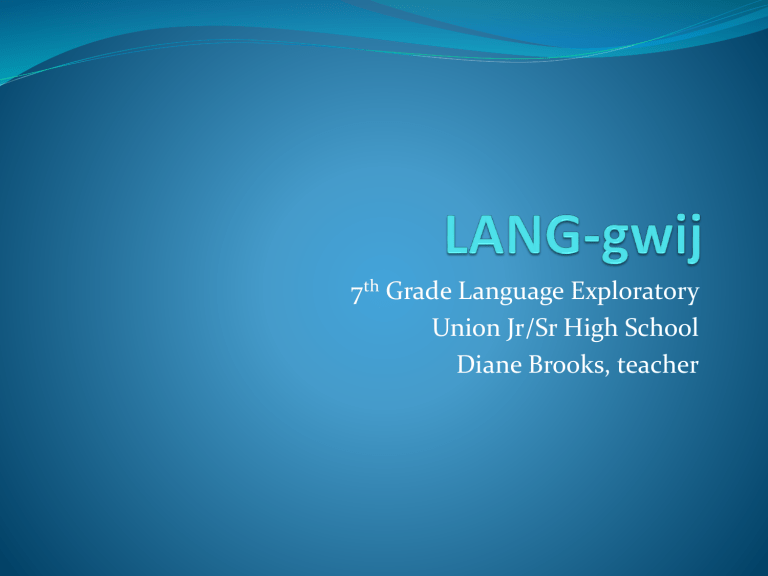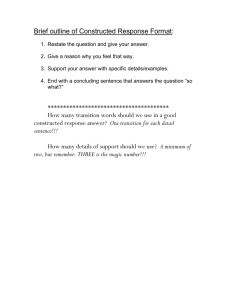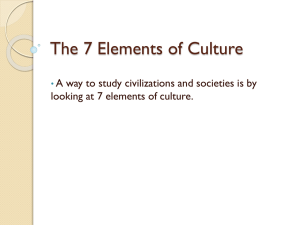LANG-gwij - TeacherTube

7 th Grade Language Exploratory
Union Jr/Sr High School
Diane Brooks, teacher
"Language shapes the way we think, and determines what we can think about.“
(Benjamin Lee
Whorf, Language,
Thought, and
Reality, 1964)
The Properties of Language
Arbitrary symbols
The symbols in a language are arbitrary
Most languages make use of sound
The symbols “nada” mean
“nothing” in Spanish but mean
“thread” in Hindi
Everyone that uses a language agrees upon the use of each symbol
This is true for words that represent sounds, such as the name ‘katydid,’ the sound the bug makes
Related Symbols
While the symbols or signs may be arbitrary, their assignment is not
The entire society must agree and cannot go about changing them arbitrarily
The finite amount of symbols provides an infinite combination of potentially meaningful utterances.
The Study of Linguistics
Linguistics is the scientific study of languages.
Linguistics has many sub-fields that change from year to year
The technical vocabulary also changes from time to time
The History of Linguistics
The Study of Languages started sometime during the
5 th century B.C. with a good look at the Sanskrit language. It described the rules and formulas for the language.
In the 2 nd century B.C. looked at grammar and syntax.
Many easterners and westerners worked on various theories over the centuries. Some of the most famous linguists are: William Jones, Friedrich Schlegel,
August Friedrich Pott, Wilhelm von Humboldt,
Ferdinand de Saussure, and Roman Jakobson.
Language and Culture are both in essence symbolic systems.
Scientists can apply the study of languages to learn about the culture of the same people.
Which came first? Thought and Reason or Language?
Well Before Darwin:
Aristotle: language was part of the intrinsic nature of man, related to their natural propensities to be "political," which in Greek meant to dwell in city-state communities
Thomas Hobbs and John
Locke: language is an extension of the "speech" which humans have within themselves as part of reason, one of the most primary characteristics of human nature
Jean Jacques Rousseau: claimed that there had once been humans who had no language or reason and who developed language first— rather than reason—the development of which he explicitly described as a mixed blessing, with many negative characteristics.
Since Darwin’s Time
Neurologist Terrence Deacon in his Symbolic Species has argued that reason and language "coevolved.’
Merlin Donald sees language as a later development building upon what he refers to as mimetic culture emphasizing that this co-evolution depended upon the interactions of many individuals. He writes that:
A shared communicative culture, with sharing of mental representations to some degree, must have come first, before language, creating a social environment in which language would have been useful and adaptive.
In More Recent Times . . .
A theory of mirror neurons has emerged in relation to language. Ramachandran has gone so far as to claim that
"mirror neurons will do for psychology what DNA did for biology: they will provide a unifying framework and help explain a host of mental abilities that have hitherto remained mysterious and inaccessible to experiments".
Mirror neurons are located in the human inferior frontal cortex and superior parietal lobe, and are unique in that they fire when completing an action and also when witnessing an actor performing the same action. Various studies have proposed a theory of mirror neurons related to language development.
Human Languages are considered to be “Natural Languages.”
Language can be:
Spoken
Signed
Written
The Natural Progression:
Languages are
Spoken,
Written, and then there is
A gradual understanding and explanation of grammar
Languages look and sound very different from each other
Languages live, evolve, and sometimes die.
Any language that ceases to change or develop is categorized as a dead language.
North American Extinct
Languages
Languages that do not die?
Any language that is in a continuous state of change is known as a
living language or modern language.
A modern language is any human language that is currently in use. The term is used in a language education context (in high schools, secondary schools, colleges, and universities) to distinguish between languages which are used for day-to-day communication (such as French and German), and classical languages (also called "dead languages") such as Latin, Attic
Greek, Sanskrit, and Classical
Chinese, which are studied for their cultural or linguistic value.
Constructed
Some individuals and groups have constructed their own artificial languages, for practical, experimental, personal, or ideological reasons.
Some writers, such as J. R. R. Tolkien, have created fantasy languages, for literary, artistic or personal reasons.
The fantasy language of the Klingon race has in recent years been developed by fans of the Star Trek series, including a vocabulary and grammar.
Constructed languages are not necessarily restricted to the properties shared by natural languages.
International Auxiliary Languages
Some languages, most constructed, are meant specifically for communication between people of different nationalities or language groups as an easy-to-learn second language.
Several of these languages have been constructed by individuals or groups.
Natural, pre-existing languages may also be used in this way - their developers merely catalogued and standardized their vocabulary and identified their grammatical rules.
These languages are called naturalistic. One such language,
Latino Sine Flexione, is a simplified form of Latin. Two others, Occidental and Novial, were drawn from several
Western languages.
Auxlang or interlanguage
The most successful auxiliary language is Esperanto, invented by Polish ophthalmologist Zamenhof. It has a relatively large community roughly estimated at about
2 million speakers worldwide, with a large body of literature, songs, and is the only known constructed language to have native speakers, such as the
Hungarian-born American businessman George Soros.
Other auxiliary languages with a relatively large number of speakers and literature are Interlingua and
Ido.
Hello
Yes
No
Good morning
English
Good evening
Good night
Goodbye
What is your name?
My name is John
Esperanto IPA
Saluton
Jes
Ne
[sa.ˈlu.ton]
[ˈjes]
[ˈne]
Bonan matenon
[ˈbo.nan ma.ˈte.non]
Bonan vesperon
Bonan nokton
Ĝis revido
Kiel vi nomiĝas?
Mi nomiĝas Johano
[ˈbo.nan ves.ˈpe.ron]
[ˈbo.nan
ˈnok.ton]
[dʒis re.ˈvi.do]
[ˈki.el vi no.ˈmi.dʒas]
[mi no.ˈmi.dʒas jo.ˈha.no]
:
Mathematics and Computer Science
Programming Languages
Animal Communication
Animal language is the modeling of human language in non human animal systems. While the term is widely used, most researchers agree that animal languages are not as complex or expressive as human language.
Linguist Charles Hockett, who proposed a list of design features of
Human Language, argues that there are significant differences separating human language from animal communication even at its most complex, and that the underlying principles are not related.
Man Vs the Apes
The following properties of human language have been argued to separate it from animal communication:
Arbitrariness: There is no rational relationship between a sound or sign and its meaning. (There is nothing intrinsically "housy" about the word
"house".)
Cultural transmission: Language is passed from one language user to the next, consciously or unconsciously.
Discreteness: Language is composed of discrete units that are used in combination to create meaning.
Displacement: Languages can be used to communicate ideas about things that are not in the immediate vicinity either spatially or temporally.
Duality: Language works on two levels at once, a surface level and a semantic (meaningful) level.
Metalinguistics: Ability to discuss language itself.
Productivity: A finite number of units can be used to create an infinite number of utterances.
However,
In several publicized instances, non-human animals have been taught to understand certain features of human language. Chimpanzees, gorillas, and orangutans have been taught hand signs based on American Sign Language. The
African Grey Parrot, which possesses the ability to mimic human speech with a high degree of accuracy, is suspected of having sufficient intelligence to comprehend some of the speech it mimics. Most species of parrot, despite expert mimicry, are believed to have no linguistic comprehension at all.
Why should someone learn a foreign language?
You like shopping on-line
You like to play video games.
You like to chat with people around the world
Everyone speaks English, right?
"I speak English, so I don't have to learn a foreign language...."
Well, certainly not everyone speaks English.
According to the CIA World Fact Book, only 5.6 % of the world's total population speaks English as a primary language. That number doubles when people who speak English as a second or third language are counted. By conservative estimates, that means that well over four-fifths of the world's population does not speak English.
It's true that English has become a global lingua franca over the past several decades. This fact, however, really should have little effect on your decision to learn a foreign language. The attitude that English alone is
enough in fact creates self-imposed limitations. To
remain monolingual is to stunt your educational development, to restrict your communication and thinking abilities, and to deny yourself the ability to fully appreciate and understand the world in which you live. Learning another language opens up new opportunities and gives you perspectives that you might never have encountered otherwise. Personal, professional, social, and economic considerations all point to the advantages of learning foreign languages.
Still not convinced?
Those are good reasons, but consider these:
1. To increase global understanding
2. To improve employment potential
3. To increase native language ability
4. To sharpen cognitive and life skills
5. To improve chances of entry into college or graduate school
6. To appreciate international literature, music, and film
7. To make travel more feasible and enjoyable
8. To expand study abroad options
9. To increase understanding of oneself and one's own culture, and
10. To make lifelong friends.





